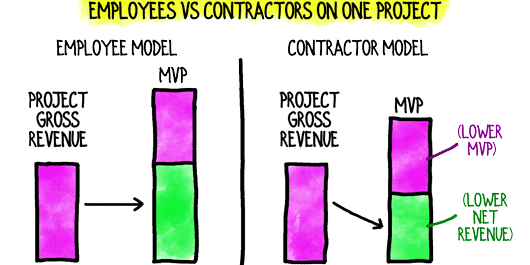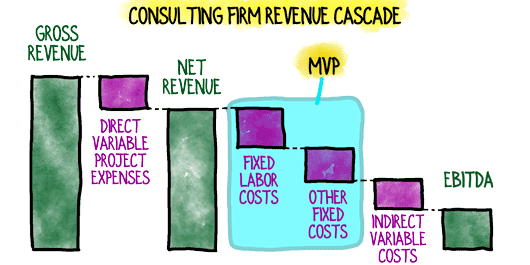With the first rays of light from the new year peeking up on the horizon, you may be pondering the goals you’ll set for growing your consulting firm. The best, first goal may be one you’ve overlooked.

By the way, if you haven’t started your annual planning yet, consider the 8-step process outlined in this article. It’s generally easier and more effective than the typical annual planning approach.
Typical goals for a consulting firm entering a new year concern top-line revenue, bottom-line margin, number of clients, and staffing changes. Most consulting firms also seek improvements on key metrics such as productivity, customer satisfaction, pun-to-content ratio, and ability to employ chocolate references without eliciting puzzled looks from clients.
The one number that could serve you best, particularly if you’re a consulting firm owner, is your MVP:
Minimum Viable Practice
Your MVP is the net revenue required to pay all of your consulting firm’s employees plus your non-discretionary expenses for the year. This is the number that keeps everyone employed (including you), and sustains the firm’s basic functioning.
Once you clear your MVP, you’re assured you can cover all your essential bills for the year. For most consulting firm owners, knowing you’re okay for the year (i.e., everyone will be paid and the lights will stay on) lifts a heavy burden from your shoulders.
Past your MVP, every dollar of net revenue funds fun, rewarding investments: bonuses, coaching, marketing, firm-building improvements, popcorn machines, etc.
Your goal: Book your MVP revenue as early in the year as possible.
My ideal is always to start the year—January 1—with the coming year’s MVP entirely in hand. That’s only happened once for my consulting firm, but I know it can happen.
Make everyone in your consulting firm aware of your MVP and their role in achieving it—they have a vested interest in hitting the MVP too.
Calculating Your Consulting Firm’s MVP
Determining your MVP is an easy, quick process. Look at your current budget or spending, and formulate a projection that strips out all bonuses, investments in growth and discretionary spends.
Cut out infrastructure improvements, most marketing, and product development. Reduce cookie subscriptions to the bare minimum of one delivery per month.
Minimizing MVP vs. Maximizing Growth
Some firm owners take pride in minimizing their MVP by trimming all expenses, running “lean and mean” and, especially, relying heavily on contract labor rather than employees.
It’s true that utilizing independent contractors rather than full-time staff will reduce your MVP.
However, keep in mind that MVP is the net revenue required to cover expenses. If you close a $100K project and require $30K in contracted help to deliver the project, only $70K (your net revenue) counts toward your MVP goal.

Also, over-reliance on contractors may reduce your quality of life, the quality of your work, and the growth potential and upside margin for your firm.
Firms that strive to minimize their MVP also tend to be under-infrastructured; i.e., the highest-paid employees are taking on a lot of tasks that are not the best use of their time.
For example, some consulting firms deliberately employ few (or no) executive assistants. As a result, time that senior personnel in those firms could be using to win more clients is, instead, spent on petty administrative tasks or refilling the snack drawer.
One final watchout when using MVP: some firms forget to add investment back into the budget once it’s apparent that the MVP will be covered.
Do you set an MVP or anything similar for yourself/your consulting firm?
Text and images are © 2024 David A. Fields, all rights reserved.

 David A. Fields Consulting Group
David A. Fields Consulting Group 


Really like your graphic on the metrics from EBITDA to Gross – it would be useful to see versions of this for different industries.
Thanks, David. Do you mean different segments of consulting or industries outside consulting? We have the bars pretty well mapped for different types of consulting firms targeting different parts of the market.